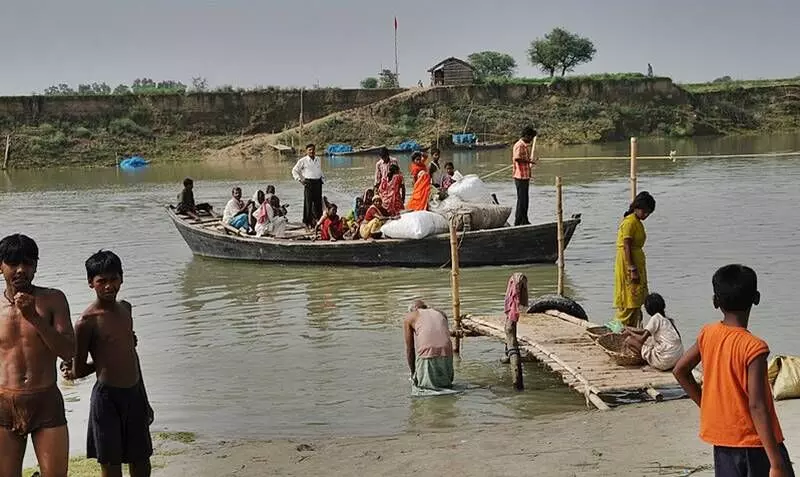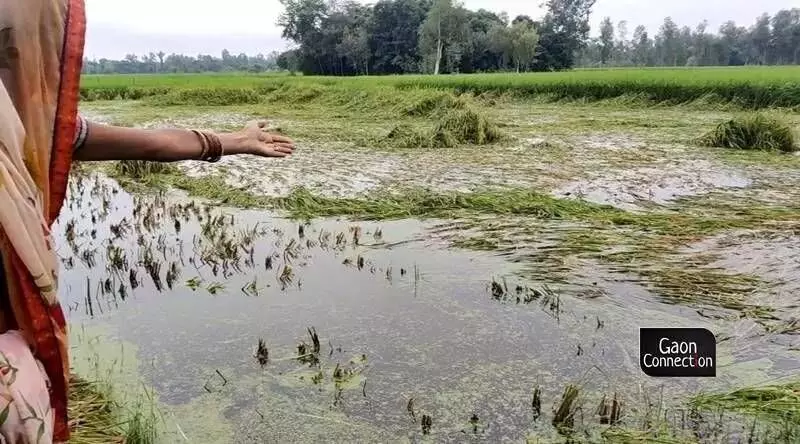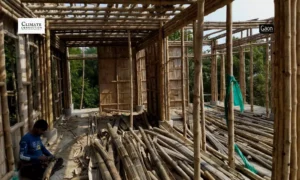Muzaffarpur, Bihar
Lakhinder Shah waited a full two months, July and August this year, to sow paddy in his 15 bigha land (1 bigha = 0.25 hectare). But his field remained uncultivated as even in the peak monsoon season, there were no rains in his village Bhatoliya, in Muzaffarpur district in Bihar.
There was a glimmer of hope for the paddy farmer when in September there was a smattering of rain. He quickly planted makka (corn) on his land, hoping he would have something to sell at the market and feed his family.
“There was no water for the paddy crops in the months of July-August. When it did rain around September, I quickly planted makka while some farmers stuck to the paddy,” Shah told Gaon Connection. “We arranged for water somehow, to keep our crops alive but now, the floods have destroyed our standing crops of corn and paddy,” the farmer bemoaned.
Shah is amongst the millions of farmers in Bihar who have helplessly stood by watching their crops being destroyed by the vagaries of nature. Till the end of the southwest monsoon season (June to September), Bihar had recorded deficient rainfall. But, in the month of October, the state has had excess rainfall leading to floods in some districts of north Bihar.

Also Read: ‘The government should declare a drought’ – Gaon Connection’s ground report from rain-starved Bihar
On October 13, the state government declared drought in 11 districts — Jehanabad, Gaya, Aurangabad, Sheikhpura, Nawada, Munger, Lakhisarai, Bhagalpur, Banka, Jamui, and Nalanda.
The government also sanctioned a sum of Rs 5,000 million from the state contingency fund as assistance to the families living in 7,841 revenue villages that fall under 937 gram panchayats (village councils). But, while the government kicked off drought relief, floods have hit other parts of the state.
Banke Bihari, a farmer from Muzaffarpur’s Sariya block said that his investment on fertilisers, water pump, seeds for his two bigha of land was all for nothing. “The urea fertiliser was overpriced when I bought it. I have spent more than Rs 10,000 on my crop. I would have reaped it next month but on October 8, when I woke up, I saw that my entire crop was flattened by floods,” he told Gaon Connection.
Meanwhile, briefing the press after the meeting of state officials held on October 13 to declare drought, S Siddharth, additional chief secretary, Finance Department stated that the officials have been asked to identify families affected by the drought and disburse the financial assistance of Rs 3,500 to each of them.
“The cabinet has also approved a proposal to survey the areas that suffered due to excessive rains and flooding in certain areas. The affected would be granted assistance by way of agriculture input subsidy,” he was quoted as saying.

Shankar Jha, an agricultural scientist, said that the fast changing weather patterns are a warning for the times to come. Photo by Creative Commons
Drought-hit Bihar…
Officials from the Bihar State Disaster Management Authority (BSDMA) told Gaon Connection that districts that register less than 30 per cent rainfall and less than 70 per cent sowing of crops are declared as drought hit.
However, the classification of the districts as drought-hit is something that has drawn criticism from the farming community. Farmers have also raised objections towards the Rs 3,500 compensation for each family.
“Every year we face crop losses… I don’t know how the government estimates our losses or on what basis the compensation is offered. I have never seen anybody getting compensated for the losses,” Shah told Gaon Connection.

Districts that register less than 30 per cent rainfall and less than 70 per cent sowing of crops are declared as drought hit.
Agreeing with Shah’s remarks, Mahendra Yadav, Supaul-based convenor of the National Alliance for People’s Movement (NAPM) told Gaon Connection that the government’s compensation of Rs 3,500 is a cruel joke on the plight of farmers.
“Even when the drought is not declared, the SOP [standard operating procedure] for crop damage mentions that if the crop damage is more than 33 per cent, Rs 6,800 is allotted per hectare of land. For crops like paddy, it’s Rs 13,500 as they demand intensive irrigation. The present compensation amount is a joke to the farmers who are reeling from poverty and neglect,” he said.
Also Read: Despite ‘above average’ monsoon, 195 districts in India reel under insufficient rainfall
… Now facing floods
According to the India Meteorological Department, in the monsoon season, between June 1 and September 14 this year, Bihar had a rainfall deficit of minus 35 per cent. Now, the state is witnessing an excess rainfall of 43 per cent for the month of October.
To make matters worse, the Indo-Gangetic rivers that flow through the states of Haryana and Uttar Pradesh have all been bringing in water from these states. Haryana and Uttar Pradesh have recorded excess rainfall by 299 per cent and 421 per cent respectively for the month of October.
Consequently, the districts of East Champaran, West Champaran, Gopalganj and Muzaffarpur in north Bihar witnessed floods, which led many residents to abandon their villages.
“The main road that led to our village was submerged in chest-deep water [almost four feet]. Women and children left the village, it’s just men folk who somehow guarded the houses. Boats were the only means of transportation available,” Hareram Mahto, a 46-year-old farmer from Puchhariya village in East Champaran district told Gaon Connection.
Also Read: Uttar Pradesh: First drought, and now 683% excess rainfall in October wreaks havoc on farmers
Surendra Mandal, a contractual farmer from Madhepur village from Madhubani district complained that he would now be forced to migrate to other cities to earn a livelihood.
“I tried my best to save my paddy which I had sown on two bighas land on batayi [contract]. But the drought was so intense that I could not save my crop. I don’t see any option but to migrate to Delhi or Punjab to work as a daily wage labourer,” Mandal said.
Also Read: Deficient rainfall and low paddy sowing fuels labour migration in Jharkhand
‘Alternative farming only solution in a fast changing climate‘
When Gaon Connection contacted Shankar Jha, an agricultural scientist at Samastipur-based Dr. Rajendra Prasad Central Agricultural University, he said that the fast changing weather patterns are a warning for the times to come.
“Drought and floods at the same time is not something new in Bihar but the problem is that the timing of the floods is getting more and more erratic. Last year, there were five floods in the state during the monsoons, but this year there was no flood till October. This irregularity in weather conditions is threatening agriculture in the state,” Jha said.

Irregularity in weather conditions is threatening agriculture in Bihar.
“The state government has launched projects like the Jan Jeevan Hariyali Mission to check the degradation of the environment but has the government ever monitored the progress of these projects? They need to be monitored for a better understanding of what’s going so wrong in the environment,” he pointed out.
Alternative crops need to be pursued as traditional cultivation is now fraught with risks, said Sanjeev Kumar, district coordinator in Saharsa’s Agriculture Department.
“Crops like makhaana [fox nuts], corn, and jute are being cultivated in Saharsa. In the neighbouring districts of Kishanganj and Katihar, tea and pineapple plantations are being promoted. Poornia is also witnessing a surge in corn cultivation. These are the ways in which farmers can get better incomes in the wake of unpredictable weather conditions,” he said.
Pallav Yadav, officer at the Information & Public Relations Department, informed Gaon Connection that the government is working towards encouraging farmers to consider alternative crops and do away with their reliance on paddy and wheat.




















